The deeper I dig into DIYing basic household foods such as rice milk or nut butters, the weirder I sometimes feel about sharing those processes here. Sure, a recipe for homemade cereal bars might come in handy, but a lot of these typical grocery store items–from tahini to garlic powder–end up being pretty simple to produce from scratch in the average kitchen when all is said and done. So perhaps you might think of these posts as more of a Pinterest board of reminders or inspirations when it starts to feel like everything you buy has soy lecithin and whey derivatives added. Sure, you can toss readymade items into your shopping basket as needed, but if you have a few minutes and don’t like the ingredient list on a given product, you can probably whip up your own with a few pantry staples.
For as easy as culturing buttermilk or kefir turned out to be, cream cheese was not a project I was expecting to be so simple. I couldn’t have been more wrong. Yogurt making is almost challenging in comparison.
Pasteurized vs. Ultra Pasteurized
Almost all the articles I’ve read on cheese making have stressed that you cannot use ultra pasteurized milk or cream (the structure of the milk proteins have been damaged). However, I find it increasingly difficult to acquire dairy that is not ultra pasteurized when shopping at a standard grocery store. The organic milk is especially bad in this regard. Apparently people paying big money for these products do not want them to spoil quickly, a concern that supersedes other considerations. And while I love using the rich fresh-from-the-cow, non-homogenized, lightly pasteurized milk I can get from the local dairy at the farmers market, that’s not always practical logistically (only obtainable on Saturday) or financially ($4 per half gallon). Many people will violently advocate for raw milk, whatever it takes to get your hands on it. I haven’t tried it, but I have made other substitutions–the cheap (probably just?) pasteurized whole milk and ultra pasteurized cream available–and still produced a tasty cream cheese.
This Is Not Your KRAFT Philadelphia Cream Cheese
Philly cream cheese is surely the standard most people (Americans, at least) will be judging any cream cheese against, and in my experience this is not that–and that’s a good thing. No matter how long I let my cheese drain, there is a shiny, spackle-like consistency to commercial cream cheese that I have not produced here. This cheese is richer and more buttery, slightly softer but not in any way runny. When adding in flavorings such as maple syrup or dill and salt and whipping briskly with a fork to incorporate, I am able to produce a lovely spread that contains no Xanthan Gum, and/or Carob Bean Gum, and/or Guar Gum, no preservatives, and no “natural flavor”. Seven days later, it still tastes fantastic.
The Verdict
I seriously doubt I will ever buy commercial cream cheese again. There is definitely a cost consideration here in terms of both the dairy and the special ingredients, but I think the taste and quality make it worth the investment (and might even encourage me to eat less and savor more). This cream cheese made me want to bake a dozen everything bagels and invite the neighbors over for brunch….At least until I remembered that my bagel baking, unlike my cream cheese making, is still a work in progress.
for tips and supplies, see Cultures for Health
Cream cheese starter cultures containing both the starter culture and rennet are available.
While culturing the cheese with buttermilk rather than a mesophilic starter is riskier due to variations in the active cultures present, I found that the taste of the resulting cream cheese was just slightly more tangy and very attractive.
In a pot (with a fitted lid for later steps), heat milk and cream to 75°F, stirring regularly.
Remove pot from stove and add the buttermilk OR sprinkle the mesophilic starter culture over the surface of the milk and allow to dissolve for two minutes. Stir gently. Add diluted rennet mixture and combine using an up and down motion with your spoon under the surface of the milk just until evenly incorporated. Cover pot with lid, wrap in a few kitchen towels, and place in a warm location (70°F-75°F) to incubate, about 14 hours.
When cheese is ready to be drained, it will resemble yogurt. Spoon into a strainer lined with a piece of butter muslin. Clip the corners of the muslin together and allow to drain over a bowl (cupboard handles and safety pins can come in handy here) until desired firmness is reached, 7-10 hours.
Mix in a 1/4 teaspoon salt or other flavorings as desired. Transfer to a container with a tight-fitting lid and refrigerate.
https://wonderlandkitchen.com/2013/04/better-than-a-silver-packet-diy-cream-cheese/
NOTE: Produces 13 ounces of cream cheese and two cups of whey.
Cream cheese starter cultures containing both the starter culture and rennet are available.
While culturing the cheese with buttermilk rather than a mesophilic starter is riskier due to variations in the active cultures present, I found that the taste of the resulting cream cheese was just slightly more tangy and very attractive.
2 cups heavy cream
2 cups whole milk
1 drop liquid vegetable rennet dissolved in 2 tablespoons water
1/8 tsp. (one packet) mesophilic starter culture OR 1 ounce buttermilk
1/4 teaspoon salt or other flavorings (optional)
In a pot (with a fitted lid for later steps), heat milk to 75°F, stirring regularly.
Remove pot from stove and add the buttermilk OR sprinkle the mesophilic starter culture over the surface of the milk and allow to dissolve for two minutes. Stir gently. Add diluted rennet mixture and combine using an up and down motion with your spoon under the surface of the milk just until evenly incorporated. Cover pot with lid, wrap in a few kitchen towels, and place in a warm location (70°F-75°F) to incubate, about 14 hours.
When cheese is ready to be drained, it will resemble yogurt. Spoon into a strainer lined with a piece of butter muslin. Clip the corners of the muslin together and allow to drain over a bowl (cupboard handles and safety pins can come in handy here) until desired firmness is reached, 7-10 hours.
Mix in a 1/4 teaspoon salt or other flavorings as desired. Transfer to a container with a tight-fitting lid and refrigerate.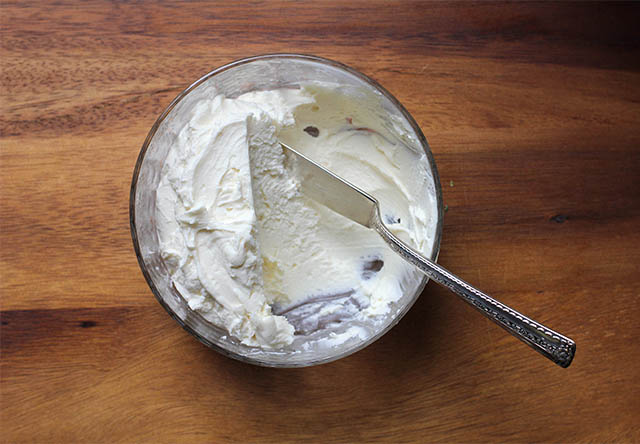

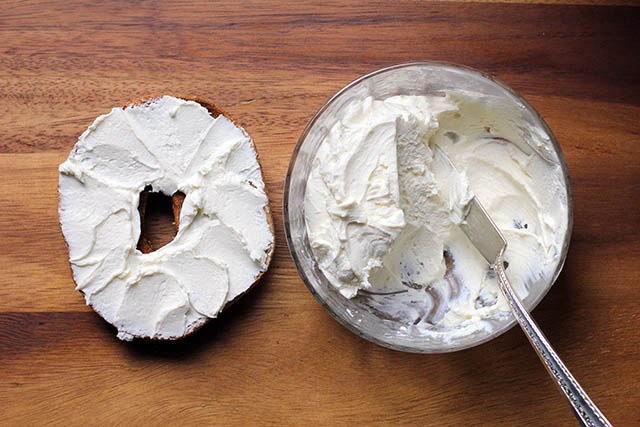
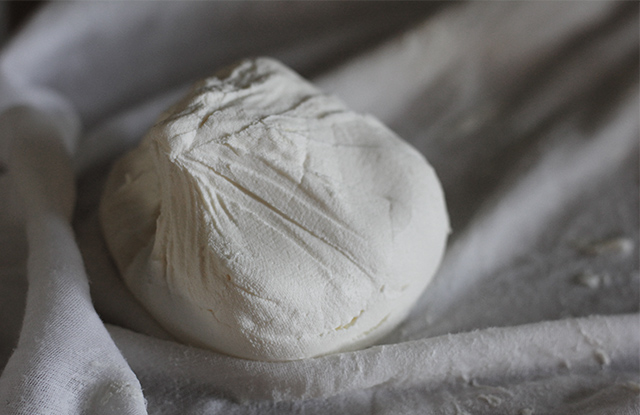
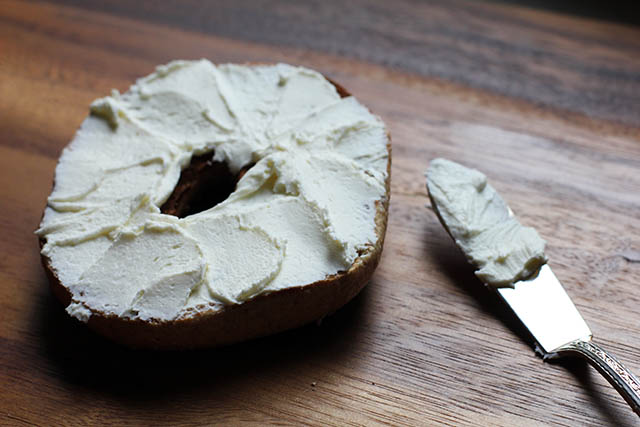









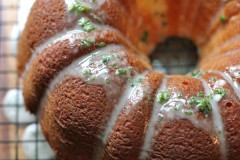
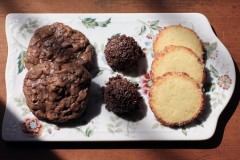
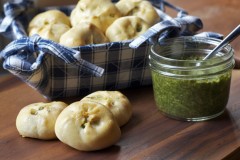


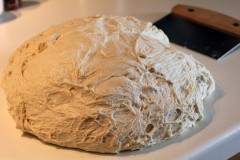




Do you know what I would do right now for a bagel and cream cheese? Terrible things. Obscene things. I can’t wait to try this recipe when I get back.
I shall make you any flavor you like in honor of your return! And I’ll do you the favor of buying the bagels from a store…
Thanks for this great post! Its so exciting for us cream cheese lovers! My question is…….What if we can’t get out hands on rennet? Would it be difficult? Also, when you say heavy cream, what exactly is that?
Hi Joyce. I’ve never tried alternative methods, but you could try something like this (no rennet) or this (strained yogurt) to get something somewhat similar. Heavy cream is sometimes also called whipping cream. It’s the high-fat portion of the milk (fat content between 36 and 40%).
@joyce, local grocery store may have rennet in jello isle for about $2.00
Don’t use that rennet; it’s different. It’s not always available at stores, but you can ask the cheese department of your local co-op or natural foods store (Rainbow grocery here in SF). Or New England Cheesemaking can ship to you.
Rennet is available in nearly any grocery store. I wasn’t sure if I would be able to find it as well and found it to be super easy.
I made this with homemade bagels and wowie wow wow amazing and super simple!
I go the lazy route and make kefir cheese which has entirely replaced cream cheese for us (the carageean and gums scare me too). 24-48 hours of straining to get the consistency, not quite as decadent but I know some people kefir culture cream as well to enrich the product.
I so meant to try that after I did the kefir post and then I accidentally put it from my mind. Thanks for the reminder!
i do that too. i have been making my own kefir for a while now and i think the cream cheese is great!! then i take the whey that is left, freeze it in ice trays and add it to smoothies for extra protein!
This is brilliant! I never thought how easy it would be, and I bet it tastes incredible. What kind of flavour variations have you tried?
I know, right?! A bit of honey or maple syrup is good for the sweets lovers, but personally I like a bit of fresh herbs and a sprinkle of salt.
[…] Homemade cream cheese. Brilliant. […]
I just stumbled across a link to your post on Food in Jars. it so happens that I started my first batch of homemade cream cheese last night. It is nice to see other people are trying it too.
Hi Molly,
First, this is a great post! I have been buying fromage blanc instead of Kraft cream cheese for a couple of years and you’re right, there’s a HUGE difference.
One thing I like about the fromage blanc that I buy is that I know that it is, in part, made from lower-fat milk and it still tastes super-creamy and rich. Have you tried making this with something other than whole milk and cream?
Thanks, Nancy. I haven’t tried making a lower fat version. I don’t eat a lot of dairy, so when I do, I have no problem going full out. I’ll have to do some experimenting!
This looks so delicious, and far easier than I’d expect! Must get my hands on some starter… :)
The recipe doesn’t say what to do with the cream….
Quite correct, Katie! Sorry about that. I meant all the dairy, not just the milk. I’ve amended the recipe.
[…] Punk Domestics: This website is full of d.i.y.-type food projects. They collect and organize recipes and techniques for canning and preserving, cheese making, home brewing and wine making, charcuterie, and more. Our recent favorite recipes found on the site include strawberry rhubarb jam, roasted tomato and jalapeño ketchup, and homemade tahini. If you’re more ambitious, there are also recipes for guanciale, ginger beer and homemade cream cheese. […]
If you add calcium chloride it will firm up your curds and you will get a higher yield. You can find it at either a home brewing store or cheese making store.
How much calcium do I use and how is it added?
Hi, do I have to use vegiatable rennet? I have animal based rennet already and don’t want to order more if I don’t have to.
Thanks!
As far as I understand it, that should be completely fine. You may need to tweak amounts, however. The vegetable rennet I used/linked to for clarity here was “double strength.” Let me know how it goes for you!
Love it! I often make things I could quickly pick up at the store in my kitchen and I am constantly discouraged by people so by all means… continue! You have my support! I am going to try this recipe as I’ve been making a list of soft cheeses to try out. My favorite part about your recipe – I don’t have to use mesophilic starter. It looks thick and rich and so so good. One question only, are you using butter muslin to drain? It’s a far tighter weave than anything I’ve seen. Where do you get it?
Hi Jillian. The cloth is definitely a fine weave and non-linty, unlike what you can usually pick up at the grocery store labeled “cheese cloth”. I got mine off of Amazon, I think. I’m not sure which I ordered, but something like this.
Old thread, but you can also look for butter muslin, which is similar and often used for cheesemaking.
i do too. i havent bought salad dressings, bbq sauce, ketchup, red sauce, protein/granola bars or dairy kefir in years. now i am starting water kefir and low gluten baking. i can not WAIT to make some of this cream cheese to put on our low gluten blueberry pumpkin seed muffins, and make my choc choc cream cheese muffins with this!!
This sounds amazing!
Silly question but could this also be used in baking with recipes that require cream cheese?
In your opinion was this cost effective?
Hi Mallory. It is awesome good. Though I haven’t tried baking with it yet myself, all my reading indicates that it is perfectly fine to use. Im my case it was not particularly cost effective because I used milk from my farmers’ market dairy, but that was part of the motivation for me, so I didn’t mind. Your own priorities may lay elsewhere.
I’ve made this recipe twice already and its great! I’ve found that three cups milk and one cup cream works best for me … otherwise it turns into butter … my whole family loves it .. thanks!!
Decided tonight to look into making cream cheese. Yours is the first site I looked at. I live in rural Haiti, have no refrigeration other then a chest freezer (powered by two batteries, off of solar panels!). Rennet I see needs to be refrigerated. Nearest grocery store is more then three hours away, and it is hot year round. Will try without.
I got into cream cheese in the past year, adding it to a Thai-influenced shredded chicken sandwich I developed. Fourteen years of eating like the locals I finally decided two years ago to learn to experiment in the kitchen..
You make it look so easy. Thanks! Off to the city next week and will by the milk products. I assume I can freeze cream cheese?
Tom: Rennet tablets are also an option and can be stored in the freezer for years. Cream cheese can be frozen, but it will likely change the texture and might then be best used in baking and such, rather than fresh as a spread. Good luck and let us know how it goes!
We have been freezing cream cheese for years. When it thaws, it tends to get crumbly, as if the liquid separates. We just use a mixer with whisk attachment, or mix by hand with a spatula forever to get the consistency back to normal. Hope that helps!
Thanks, Leah. Great to hear from someone with first-hand experience.
I am trying to serve my family more “homegrown” foods, and we happen to be be cream cheese junkies! This makes me a very happy girl! Thank you for the post! Can’t wait to try it!
Definitely going to try this! Have just been adding up our dairy bill lately and it’s obscene, so ready to start branching out a bit.
Side note– as I understand it, the reason organic dairy is ultra-pasteurized is that there’s less of a demand for it, so UHP makes it last longer and therefore they lose less money on a niche product.
…but I’m with you, I prefer not UHP. :-)
That totally makes sense, and I will confess that when my farmers market dairy starts to go “off” within a much shorter time frame, I’m always kind of annoyed and need to stop and check my spoiled self :)
I know, I always think the biggest thing that will hold people back from better dairy (raw) isn’t fear of it, but lack of willingness to deal with less convenience! :-D This might be a cop-out, but I’ve settled for buying a gallon of UHP organic for cooking (because it gets pasteurized anyway if it’s cooked) and I shell out the big bucks for the real stuff that will be consumed raw. I’m okay with that. :-D
Hi Molly,
I hope you don’t think I’m being nosy. I’m not a member and I probably won’t be back to the site. I read the trouble you had with getting the stiff consistency of Philly cream cheese. If you tie the cream cheese tight into a cheesecloth, put it into a strainer over a bowl to catch the liquid, and then put a weight on top of it (a heavy glass bowl or anything else), a lot more moisture will come out than just letting it free stand while it’s draining. Hope this is useful and not rude of me to offer uninvited.
Hey, Sean. I actually wasn’t looking for any thicker a consistency myself, but didn’t want readers to be surprised. However, for those who do, thanks for sharing your idea!
Hi! I’ll join company with Sean and add my 2 cents : ) I find jelly bags perfect for straining. They hang nicely off upper cabinet knobs. Today making 3.5 gallons of whole milk into cream cheese and whey for healthy lacto-fermenting. I use piima culture I got online. Nourishing Traditions cookbook has awesome recipes to use the whey to make lox! (And pickles). Search for it online or @ the local libray, its got lots of yummy recipes that use the whey. I bet any type of culture would be great (yogurt, piima, kefir) w/ nuances in flavor…have also heard of peeps just use lemon juice to curdle the milk. More power to you all–may your fearlessness be rewarded!
[…] Survival Betty Homemade Cream Cheese Recipe and Photo https://wonderlandkitchen.com/2013/04…-cream-cheese/ […]
This is absolutely fantastic!!! I’ve been wanting to make cream cheese for a while and this looks perfect :)
1. What kind if buttermilk? Can I use the buttermilk that is actually leftover from butter making? Or does it have to be the store-bought kind…?
2. Do you think goats milk can be used?
Hi, Julianna. Store-bought or DIY, what you really need is the culture, so just what’s left from the butter making won’t work unless there are active cultures involved (and that depends on how you make your butter). I don’t see why goat’s milk wouldn’t work, but I don’t have any experience working with it.
When you say DIY buttermilk, could this be the types made from milk and lemon or vinegar? I would love to start making our own cream cheese, but don’t necessarily want to add buttermilk to the grocery list…
Hi Ericka. No, you need the active cultures, so if you want to avoid extra grocery items you might not use, I’d go with using the powdered mesophilic starter.
[…] Cow milk ricotta Goat milk ricotta Cream cheese Butter, cultured and […]
Thanks for posting this recipe! I was wondering, do you have any use for the drained liquid?
Hi, JD. I like to use the whey as a replacement for water in bread and pizza dough recipes.
you can also freeze the whey in ice cube trays and use it for extra protein in smoothies. i used to buy this expensive whey to add more protein to our smoothies, but since i started making cream cheese from my homemade kefir, i just use that whey protein instead!
Hi,
I have a Jersey heifer that is due to calve in June and I can’t wait to try this with fresh from the cow milk. I’m also hoping to learn to make sour cream and cheese. We used to have a dairy and I made my own butter all the time but I am excited about venturing out into new dairy products.
Thanks!
How exciting, Julie! Please stop back and let us know how things go.
I just found this page when I googled “cream cheese not tart enough” I made some cream cheese with a culture from cultures for health that was specifically for cream cheese. The resultant texture wasn’t too bad, but it was not tart and tangy like store bought. Any ideas for a tarter cream cheese?
Hmm, can’t give first-hand advice here, but if it was me I’d try adding time to the culturing, similar to making yogurt more tart. Readers, any thoughts?
[…] yummy, fresh cream cheese without the preservatives? Try this recipe to make your […]
do you let it get firm for 7 to 10 hours before you put it in the fridge or do you let it firm up in the fridge?
Hi Ty. The draining process happens at room temperature. I knot my cheese cloth to a cabinet handle over the sink, which works out pretty neatly.
rennet is really hard to find where I come from, but I have animal rennet on hand from making mozzarella, will that work?
Yes, Kristen. I was using a double strength vegetable rennet, so you’ll just want to up yr drops, I’m guessing.
Did you mean “no artificial flavors” instead of natural flavors?
Nope, I meant “natural,” though there aren’t any artificial flavors either of course.
I loved your post about cream cheese. I,too, make cream cheese AND yogurt. My husband even made me a device to hang the sack of draining cream cheese. I’ll be posting about it on my vegetarian cooking blog, complete with picture. It also works to hang freshly made pasta. VegCookingForCarnivoresBlog.com
Nice! Much classier than my go-to pasta-drying methods, which usually involve wrapping a long dowel rod from the basement in plastic wrap and balancing it between two kitchen chairs.
That’s too funny, Molly. The reason my husband built the device for me was he got tired of moving the long wooden spoon I used that rested between the orange juice and milk containers. We women have to be creative!
How long can the home made cream cheese be stored in a fridge before it goes bad?
Cream cheese can be stored a couple of weeks. But, you can freeze it if you need it to last longer.
[…] Sheridan, wonderlandkitchen.com / […]
[…] cheese. There are many, many recipes for cream cheese floating around the internet. I opted for one found at Wonderland […]
hi would like to know if you can add sugar to make it sweeter in the when making cheese
You can add sugar, salt, anything you fancy after the cream cheese is done draining. It’s really pretty bland unless you add some flavouring. But if you’re using it in baking, you should probably just leave it since you’ll already be adding in sugar (such as in cheese cake). NOTE: go slow – add in only a little at a time and taste. I have a DIY video for cream cheese at: http://www.youtube.com/watch?v=lw_fzIuIqY8
Hi! Sorry if this has been answered, but how much does this make? Do you end up with a lot of leftover whey like you do with ricotta? Can’t wait to try this. Thanks!
[…] instead of cream cheese in baking, so fingers crossed it will be OK. I do want to try making proper homemade cream cheese. I just need to pick up some rennet. (Which would also mean I could make homemade mozzarella. I did […]
Hey Molly, thank you for this interesting post! You method seems really nice & simple. I can’t wait to try it, but I only got tablet veg. rennet. Do you know how much I can use for the amount you have mentioned. And also can I substitute better milk with yoghurt??
[…] is super, super easy. Mix, wait, strain…poof! you’ve got cream cheese. I followed the cream cheese recipe on Wonderland Kitchen, and it really came out […]
Hi Molly! This looks awesome and I cant wait to try it!! Can i use this recipe to frost, say, a carrot cake? Would it work?
Shouldn’t be a problem! The consistency of the cheese may me slightly softer so you may just need to adjust some of the other ingredients in the frosting to account for that. Let me know how it goes!
Noooooooo! I tried your yummy recipe and it didn’t work! Here are the reasons I think it went wrong…..
1. Used animal rennet – 1 drop
2. Used buttermilk from my home made butter
3. Used double cream, not whipping cream.
4. Used full fat organic pasteurised milk as cannot get unpasteurised in Scotland.
Am planning to try again. Any advice gratefully received.
Hi Eilis. Sorry you had a disappointment here. I’m going to guess that it was the buttermilk if you simply used what was left over after making butter and you were not making cultured butter. That type of buttermilk is not quite what traditional buttermilk or today’s store-bought buttermilk are because it’s fresh and not cultured. You can read more about the differences here.
Not done home made in decades so need info: mesophilic, how or where do I get this? ty
I just tried this with yoghurt straining recently – but there was mildew forming on the cloth when I took out the cream cheese after 24 hrs. And the resulting cream cheese (although looking amazing) tasted quite overpoweringly like mould! I live in a fairly warm climate (Barcelona) could this be the issue?
Hi Bianca. Were you using new cheese cloth/butter muslin? I have never had a issue with mildew in such a short time, and I live in a pretty swampy area of the Mid-Atlantic. When I strain yogurt rather than cream cheese (as you’re doing here), I do keep it in the fridge during the draining, so that’s an option for you. I leave mine sometimes even longer than 24 hours for super thick results.
I make cream cheese by straining organic whole-milk yogurt through a cheesecloth overnight. I hang it from a cabinet, with a bowl underneath to catch the whey. Turns out great every time! I usually let mine drain for 6 hours or so for a firm consistency, but I’ve also done it for only an hour for a sour cream consistency. (Okay I’m not sure if this is technically considered cream cheese, but it works great). :)
I’m a fan too! It’s actually not technically cream cheese, but is often referred to as yogurt cheese or labneh. I agree–it’s a great topping and an awesome alternative.
Hi. I just had a question, can you use homemade buttermilk made from lemon juice for this recipe? I just recently got diagnosed with an allergy to Carob/Locust bean gum and I was hoping to make my own cream cheese, but the only buttermilk I can find has Locust Bean Gum in it. Thanks!
Hi Taryn. Sorry to hear about your allergy! Unfortunately, that trick for souring milk will not work in this case as what you need are the cultures. You can make your own cultured buttermilk (https://wonderlandkitchen.com/2012/11/diy-cultured-buttermilk/) or use the powdered culture starter.
Hi Molly, I’m new to cream cheese making and was really excited to try your recipe. It didn’t work but I think it was because I left the mesophilic cultures on my counter for a couple weeks (!) before finally remembering to put them in the freezer. I’m going to order a second packet through Amazon, did you put yours in the freezer right away when you got them? Also, does it make a difference if it’s pasteurized or unpasteurized milk and cream? (sorry if someone already asked this question, I didn’t read all the posts yet) Thanks!
Hi Crystal. Freezing the cultures is really more to lengthen their shelf life. I don’t think they would have gone off that quickly. I suspect that your issue is more likely tied to the type of milk you used. UHT pasteurization can be problematic though I’ve never had an issue with my local dairy milk which is pasteurized.
Hello! I’ve never made cream cheese before but found this recipe. I’ve put the butter muslin in my Amazon cart. However, I’m finding several kinds of Mesophilic so I’m wondering which one I need. I have the Mesophilic C101 – 5 Packets in my cart waiting. Also, I see 2 kinds of rennet. Vegetable and animal. Which do I use? Thanks!
Thanks for your recipe… I just made amazing cream cheese by simply draining my yogurt with butter/cheese cloth and after the whey dripped out…viola! Cream cheese…its awesome and still tastes amazing after 2 weeks! The whey i had lasts months in the fridge and i used it to ferment pickles! So easy and all i needed was yogurt…ive made it with store bought plaon yogurt and it works just as well
Hi, can this diy cream cheese be still whipped for makin a no-bake cheesecake?
Cream cheese, can it be frozen and then used to bake or cook with?
[…] Basically this recipe. […]
I recently discovered home made cream cheese (and fetta) at an all you can eat restuarant called the conservatory at crown casino and they were fantastic! I cant wait to try your recipe, as I think I know exactly what you mean by it. I thought I might share with you, the cream cheese an fetta made at the restuarant were encased in glass pots and what I believed to have been just plain olive oil cause it was light an not heavy textured or favoured. Yhe oluve oil coukd have also been just to oreserve it longer but I remmber eating arabic cream cheese balls like this as a kid wen my dad would buy the cream cheese ball then smash it into olive oil. Another cream cheese to try! Its rolled in black dried herbs. Add fresh chopped tomato, fresh onion, olive oil, an this purple herb I think called sumak?! And enjoy!
[…] for something to spread on your bread, we suggest making Wonderland Kitchen’s rich and tangy Cream Cheese. The recipe yields 2 […]
I’ve had great results by bringing the cream up to blood temperature and acidulating it slightly with a few drops of lemon juice. Then I add about a teaspoon of rennet and it curdles instantly. The resulting creamy curd is perfect for when I’m making a cheesecake but it’s more like ricotta than shmeer. I guess you have to choose between waiting a long time and a certain texture. You can’t have both it seems!
I cannot wait to make this and make a cheesecake! WOOHOOO!
so Far so good. My cream cheese is draining. Here in Paris you can buy a product called Lactaline made by Yalacta, which incorporates both cultures and the rennet. You can find it in most pharmacies.
So now I’ll definitely have to make Bagels from scratch :-)
I made this last weekend & also made homemade bagels to go with it. Both were fantastic!! Thanks for the recipe :)
Sheri, you’ve bested me! I’ve always wanted to do that for an awesome porch brunch party but have never actually managed to execute it all at once. So happy to hear that this worked out for you!
Thank you.
Very appreciated.
I followed this recipe exactly and had no luck. I wondered if the temperature in the beginning was too low, because honestly my ingredients which were at room temperature were already there. I have made other cheeses before with success and am wondering what I did wrong with this one.
[…] I want to get more into making our own cheese. I love homemade ricotta, and I would like to try cream cheese next before moving onto hard […]
Can I use coconut milk than cows products?
I have seen instructions for this online, but it’s a completely different process, similar to straining yogurt. Do let me know if you like it!
This recipe looks great! How long does the cream cheese keep in the fridge?
Mine is never around more than a week, so I don’t feel I can make a good appraisal here.
so should we NOT use buttermilk?
Feel free! I liked the taste, but you just have to make sure the buttermilk you use has still-active cultures.
[…] DIY Cream Cheese via Wonderland Kitchen […]
2 questions….first, how long does it stay usable in the fridge? second, we are planning to start buying raw dairy, so would the recipe be the same? would you use the cream that rises to the top as the heavy cream, and the milk as the whole milk? making thia TODAY.
I can’t thank you enough for this recipe. My husband has a blood deficiency called G6PD and a lot of the ingredients in store bought cream cheese he can’t have. Thanks so much! Can’t wait to make this
I’m in the process from straining and I couldn’t help taste a little and the milk tastes like it may have gone bad! Is that normal flavoring for cream cheese?
Hi Aisha. In my experience homemade cream cheese has a very fresh, rich and buttery taste. It sounds like something may have gone amiss for you.
You said the MILK tastes like it has gone bad…are you tasting the cream cheese part or the liquid that has drained out. Yes it should be creamy and buttery, but there still should be a little “funk” too. It should be slightly sour, but clean. And if you are tasting the liquid (whey) it will taste a bit sour or slightly bitter. How long ago did you make the kefir?
I tasted the cream and I thought it tasted funny. Similar to when milk goes a little sour. It’s been out straining for 1.5 days now. What had happened was I used a flour sack towel, and a single layer didn’t strain well. Most of the mixture went through and I didn’t realize until I went to check 7-8 hours later. So I doubled another towel and poured the milk back in to let it strsin. And now the whey separating as it should but the cream part tastes funky
I wouldn’t chance it.
Hi,im a cream cheese fanatic. I put it on everything so i wanted to try it. I dont know what exactly mesophilic starter culter is or where i could find it at.
How long is does this stay good in the fridge ?
Have you ever tried it using fresh goats milk? I am going to try this using fresh cows milk, fresh from the farm. I will let you know what happens.
I am very interested in making this, but, what is mesophilic starter and where do you get it from? Thanks for your help.
We make kefir from some of the raw milk we get every week from a local organic dairy. I use the kefir in place of cultured buttermilk in making a spreadable cheese (not cream cheese, but similar). Will kefir work in this recipe instead of the mesophilic starter culture?